BISAC NAT010000 Ecology
BISAC NAT045050 Ecosystems & Habitats / Coastal Regions & Shorelines
BISAC NAT025000 Ecosystems & Habitats / Oceans & Seas
BISAC NAT045030 Ecosystems & Habitats / Polar Regions
BISAC SCI081000 Earth Sciences / Hydrology
BISAC SCI092000 Global Warming & Climate Change
BISAC SCI020000 Life Sciences / Ecology
BISAC SCI039000 Life Sciences / Marine Biology
BISAC SOC053000 Regional Studies
BISAC TEC060000 Marine & Naval
The opening of relationships between United States and Cuba could be a drive for a huge increase in the affluence of tourism to Cuba and especially to the coast areas. Cuba has been for many years an important tourist destination for people from many countries, but almost forbidden for US citizens. The proximity of the USA, its amount of population as well as their great acquisition power will increase in a very substantial way the demand for accommodation and other uses in the proximity of the coasts. There will be a need to implement a package of measures that reduce the impact of such sudden increase in the coastal line. On the other hand that augment in tourism could be an opportunity to improve the standard of life of Cubans. The consideration of different possibilities of such development, the analysis of the damages that each one could cause as well as the measures that could avoid, ameliorate or compensate such effects are the goals that are going to be presented in this paper.
Tourism, cruisers, pollution, development
I. Introduction
Cuba is a country that since long time ago has relevance in the world that could be considered superior to its size, population and even political influence. The latest events regarding the aperture to new relationships with the United States open new perspectives to what may be the future of relationships between the two countries. The United States has a large weight in the economy and politics of any country in the world. But for Cuba this influence is even greater. First because there is an obvious reason that is the proximity, and secondly the long isolation that the embargo has led to Cuba. The fact that Cuba is an island makes that almost every activity has to be related to the sea and its shores, which are one of its most important assets.
The sea represents the genuine mean to transport goods entering and leaving the island. Fisheries are another source of wealth from the sea. But tourism have an increasing importance not only in Cuba but worldwide. The possibility that the barriers for US citizens to visit the island disappeared could abruptly change the status of the tourism activities. The effect that this change desired since long time, but not expected with a degree of certainty, makes any forecasting quite difficult.
Cuba is in a geographic area that offers many opportunities for tourism. The main demand for tourism in the area is in the United States. Cuba has been left out of this demand for over fifty years. So the picture that opens is, on the one hand, promising from the point of view of a very rapid development, but carries certain risks as potential damage to the natural, human and cultural environment.
It should also be noted that the environment is one of the assets that make it attractive to tourism, and that any damage to it may impact on tourism itself
Foresee the exact demand for tourism by the market of the United States is not an easy task. But as the current demand is known to nearby destinations, it could give some clues [1]. The pressure of the major tour operators can be very strong for the arrival in Cuba of large numbers of American tourists. Already today Canada is the country that sends more tourists to Cuba. The number of cruises from ports of the United States could be increased very rapidly. The lack of enough hotel rooms could be replaced by the cruise boats. The impact over the coasts would be double, one the occupancy and development of the seaside, and the other the increase of the maritime transport in the island.
All these aspects could mean a threat to the environment in Cuba. But there are also benefits in all areas. The task is to combine the development that the Cuban people need and deserve, so that it is sustainable, that means that can last over time by respecting the natural heritage and intangible assets as the traditions and the idiosyncrasy of the population
The natural coast, with beaches, reefs, mangroves and all the fauna and flora could suffer impacts from this new «invasion» of visitors. But small villages, towns or cities as Havana could be exposed as part of the coast to the impact of the new arrival of those thousands of visitors.
II. The past and the present
Tourism is a sector that the development strategy placed in a prominent place, as a potential source of foreign exchange earnings for the country. This meant an exploitation of geographical and climatic conditions for the development of this activity. For the development of tourism is intended to expand the accommodation capacities and development of the necessary infrastructure [2].
In the 50 tourism was a very active sector in the Cuban economy and the US tourism to Cuba represented 85% of the total. Cuba had a share of 30% in the Caribbean. The vast majority of foreign visitors were staying in Havana, and that stage they date the great hotels built in the capital. Since the political, social and economic transformations in Cuba in 1959, a political, diplomatic and commercial rupture with the United States which dived to a decreasing in that crucial source of tourism. Some European countries from the socialist bloc did not fill that space, and the proper orientation of the economy was directed to other programs considered most important for the development of the country at that time. All this conditioned that in those years the international tourism was minimal, but took some important domestic tourism with an uncompetitive infrastructure. In the eighties of last century it began some reopening international tourism. Since 1990, with the collapse of European socialism and the need to seek new economic alternatives, a new approach to development activity projects took place. The first joint ventures in the sector were created accelerating visitor arrivals as well as revenue growth. Since 1996, when first attained over a million visitors, Cuba proposed to consolidate as a world destination in the Caribbean, based on Cuban natural and cultural potential[3].
At present the country that sends more visitors to Cuba is Canada with a 39% (Fig. 1). Other countries are quite far. The number of visitors from Spain, Italy and UK has decreased in the last years, due to the crisis and the competition of other destinations.
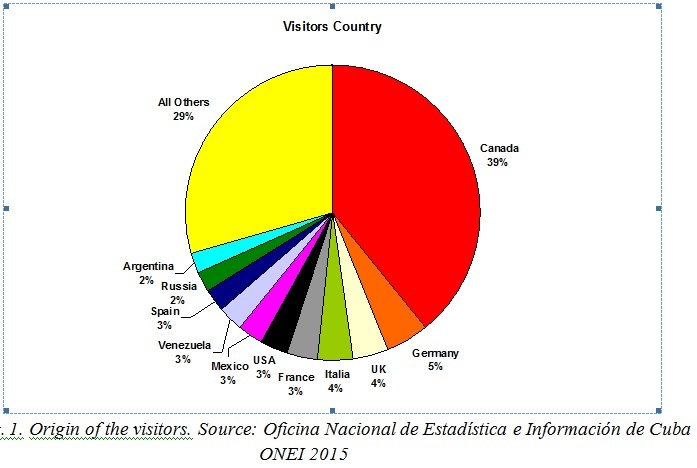
Fig. 1. Origin of the visitors. Source: Oficina Nacional de Estadística e Información de Cuba ONEI 2015
The number of tourist has increased in a continuous pace 2009 (Fig.2). The average annual increase is of 4%. In recent years, there has been a slowdown in the increase of visitors. The tourism from United States have increased since 2009 (Table 1). Nevertheless there are estimations that almost 300,000 Cuban born USA citizens visit Cuba each year, although they are not considered for the Cuban Government as foreign visitors[4].
Table 1. Visitors from the United States. Source: Oficina Nacional de Estadística e Información de Cuba ONEI 2015
|
USA Visitors |
|||||
|
2009 |
2010 |
2011 |
2012 |
2013 |
2014 |
|
52,455 |
63,046 |
73,566 |
98,050 |
92,348 |
91,254 |

It is difficult to know the exact amount of the tourist sector in the Cuban economy. The data from the official statistics give the figure of 4,6 % of GDP only for hotels and restaurants. So it could be estimated that the real weight of tourism due to induced activities is about 10%. In the Juventud Rebelde site the figure is 7% http://www.juventudrebelde.cu/cuba/2015-09-27/cuba-reconoce-valor-del-turismo-en-economia-nacional/. The tourist sector represents the 22% of the international trade [2].
The demand varies along the seasons of the year. The months of winter are the ones with more visitors. Many of the Canadian visitors chose those months because is when they have worst climatic conditions, and as they are the most important origin of tourism they govern the demand data.
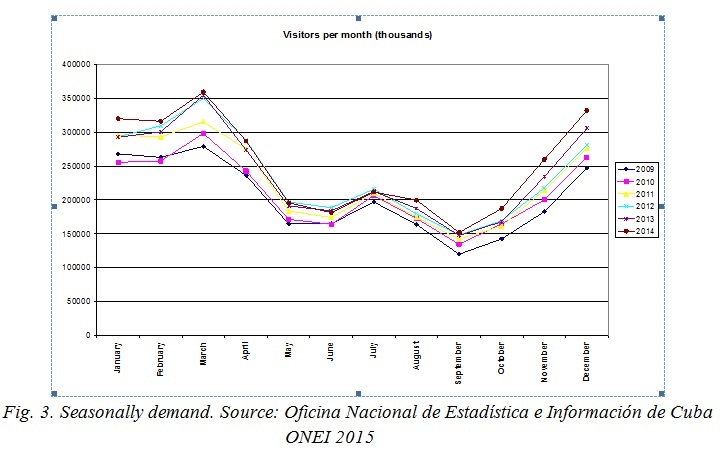
It is also valuable to analyze the type of tourism. Many authors point that the majority of tourists look just for sun and beach. The data shows that there is a great interest in visiting Havana although the number of days of stay is 3, but the income per day is proportionally higher than in sun and beach destinations. In Table 2 only Havana and Santiago could be considered as not beach and sun destinations, where the cultural attraction is the main reason for the stay.
Table 2. Destinations Source: Oficina Nacional de Estadística e Información de Cuba ONEI 2015
|
|
Visitors |
Days |
Rooms |
Ocupation |
Income |
Visitors·day |
|
Havana City |
1.126.144 |
3,2 |
12.301 |
49,60% |
$642 |
3.603.661 |
|
Varadero |
1.016.684 |
10 |
16.196 |
64,70% |
$1213 |
10.166.840 |
|
Holguin |
386.807 |
8 |
4.817 |
62% |
$240 |
3.094.456 |
|
C. de Avila |
229.199 |
8 |
4.146 |
50% |
$123 |
1.833.592 |
|
Cayo Largo del Sur |
59.943 |
9 |
1.113 |
59% |
$29 |
539.487 |
|
Santiago de Cuba |
108.325 |
3,3 |
1.826 |
29,30% |
$68 |
357.473 |
In Fig. 4 shows how the number of visitors to cultural destinations is quite high, but when multiplied by the number of days it decrease in a considerable way. Nevertheless the appeal of Havana and the policy of rehabilitation could change the amount of such differences.
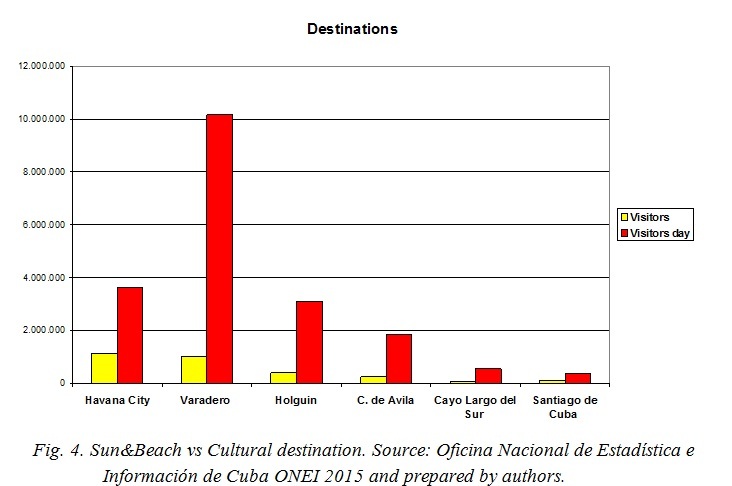
But the island has serious infrastructure problems related to transportation systems, communications, Internet access, financial services, etc., which result in low quality and high cost of these services. To this must be added the support of an exchange rate artificially revalued the convertible peso that drive to expensive tourist services in the island that are over its neighbors that offer better infrastructure in similar natural conditions, and so leads to the loss of competitiveness of the Cuban tourism industry [2].
These trends show a situation of relative exhaustion of the possibilities of the extensive model of sun and beach as a pivot.
The aim to continue with growth, economic development and international integration would lead to assume that only it will be possible with significant changes in the infrastructure supporting tourism, and in the international environment, especially of US laws as well as the internal reforms that open the participation of Cubans. The participation of foreign investors will be crucial, but with a clear and open conditions that respect the labor rights, the environmental and a fair business conduct.
Environmental damage was mainly due to the historically inadequate planning in agriculture, industry, transport, fishing and tourism. Unlike many other countries, there are few environmental groups and activists to force the strict enforcement of environmental laws. In addition, policy in Cuba is still centralized and citizens rarely turn to the courts to challenge the decisions they do not agree with. Whatever the outcome of this debate, it is clear that foreign investment and the work of governmental and non-governmental organizations will play an important role in increasing the responsibility taking the right choices and the management of its coastal areas and ocean [5].
III. The pressure: The cruise sector
One of the possible changes that could take place in a near future is the augment in the demand of cruises to Cuba and especially to Havana. This is a kind of tourism that is very popular in United States. It will be the easiest way to transport thousands of people to Cuba for tourism. The hotel capacity of Havana it is not prepared to receive such amount of visitors.
The future of the tourism in Cuba will be indefectibly linked to the cruises. The cruise market represents worldwide a market of 39,600 million of dollars, and is growing at a rate of 6.9% from 2014 due to the fact that there are more cruisers with higher capacity as well as higher prices. The number of cruise passengers carried worldwide in 2015 could be around 22.2 million, a 3.2% increase over 2014. The sourcing of passengers worldwide is 58.6% North America (Canada, United States and Mexico) followed by Europe (25.9%), Asia (8.5%) and Australia (4.3%). The capacity of worldwide cruise at the end of 2015 is 490,000 passengers and 300 ships.
The average price per persons is $1780, a 3.5% increase over 2014 and the average spending per day $222 with an average cruise duration 8.0 days.
The top three cruise companies Carnival Corporation (NYSE: CCL), Royal Caribbean Cruises Ltd. Co (NYSE: RCL) and Norwegian Cruise Line Holdings Ltd (NASDAQ: NCLH) have 82% of worldwide passengers carried and 77% of revenues[6].
Table 3. The cruise market. Source: Cruise MarketWatch
|
Cruise Company |
Passangers |
Revenue |
|
CCL Carnival |
48,10% |
42,20% |
|
RCL Royal Caribbean |
23,10% |
22,10% |
|
NCL Norwegian |
10,40% |
12,40% |
|
MSC Cruises |
5,20% |
4,20% |
|
Disney |
2,80% |
2,40% |
|
Thomson Cruise |
1,30% |
1,80% |
|
All others |
9,10% |
14,90% |
Table 3 shows which are the most important cruise companies, and the degree of concentration of such market. Any future development of the cruise activities in Cuba will requires the participation of those companies.
In the Caribbean, the destinations and number of passengers are shown in Fig 3. Bahamas leads the demand with near 6.6 million visitors, and 3300 cruise ship calls. The total amount in the area in 2014 was 21 million and 9300 ship calls.
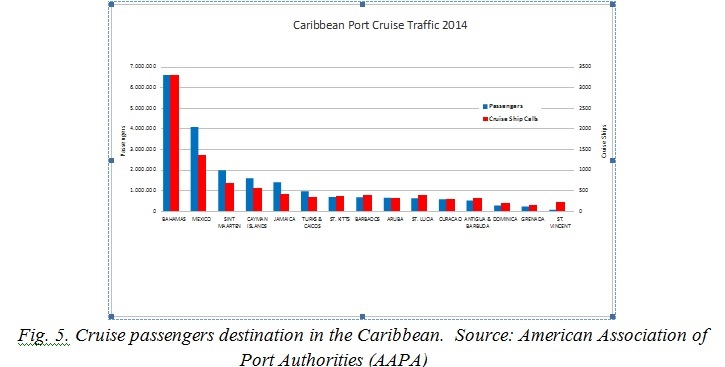
That means that even a small percentage of such market derived to Cuba could represent a great change in Cuba maritime conditions.
The ports of origin are among the most important cruise ports of the world and are in the United States. The cruise traffic in USA is the 60% of the world, while Europe has the 26%
Table 4. Ranking of cruise ports. In grey the ports of cruise origin. Sources: Various
|
Rank |
Port |
Country |
Passengers |
|
1 |
Port of Miami |
United States |
4.850.000 |
|
2 |
Port Everglades |
United States |
4.160.000 |
|
3 |
Port Canaveral |
United States |
4.001.000 |
|
4 |
Port of Nassau |
The Bahamas |
3.412.000 |
|
5 |
Port of Cozumel |
Mexico |
2.700.000 |
|
6 |
Port of Barcelona |
Spain |
2.364.292 |
|
7 |
Port of Civitavecchia |
Italy |
2.140.039 |
|
8 |
Port of The Virgin Islands |
United States |
2.083.890 |
|
9 |
Port St. Marteen |
Netherlands |
2.000.864 |
|
10 |
Port of Venice |
Italy |
1.733.839 |
|
11 |
Port of The Balearic Islands |
Spain |
1.587.064 |
|
12 |
Port of Southampton |
United Kingdom |
1.529.000 |
|
13 |
Port of Marseille |
France |
1.311.284 |
|
14 |
Port of Naples |
Italy |
1.113.762 |
|
15 |
Port of Piraeus |
Greece |
1.055.556 |
|
16 |
Port de Genoa |
Italy |
1.051.015 |
|
17 |
Port of Savona |
Italy |
1.018.794 |
|
18 |
Port of New Orleans |
United States |
1.014.325 |
|
19 |
Port of Galveston |
United States |
901.000 |
Moreover, the average growth of this sector since 1990 is the 7% and the forecast for the future is to keep on this amount. (Fig. 6). So again the likelihood that Cuba embraces the group of countries in the Caribbean that share the most important cruise traffic in the world is really very high. That represents on a one hand an opportunity for the quick improvement in the conditions of the people, but on the other it could drive consequences for the environment.
It has to be taken into account that the number of passengers is really the revenue passengers, which means the number of embarkations, disembarkations, and in-transit.
Other modes as air transport can be also be increased when the embargo will finish, and those visitors could cause an impact on the coasts, but cruises are more easy to be deployed and the effect in the coasts are immediate.
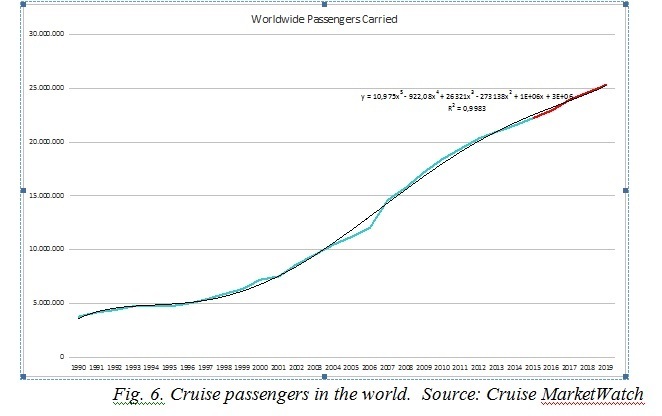
As it was pointed out in the OCDE report by Merk the value added generated by cruise activities is relatively limited. Cruise port impact studies generally look at three categories of spending resulting from cruise tourism: cruise line spending, crew spending, and passenger spending. The crew category is negligible. Passenger spending is generally accounts for the largest share of revenues from cruise tourism in ports of call, particularly in island economies (i.e. the Caribbean). The average economic contribution per passenger in a cruise port is USD 200. It is not a large amount but could be significant for the Cuban economy [7].
IV. The effects of a tourism boom
The Cuban environment has experimented since many years ago some kind of pressure due to new tourist developments. But the new situation could change in a dramatically way the present conditions. This does not necessarily means that all the changes will be harmful for the environment, but it is necessary to deal with it in a careful way. The opening of Cuba to the United States tourism is an opportunity for improving the conditions of the Cubans and for ending the isolation with its neighbor, but also to ease the relationships with other countries that are distorted by the restriction imposed by USA laws.
Cuba is home to some of the world’s most amazing coral reefs, located among of the Atlantic Ocean, the Caribbean and Gulf of Mexico. Its extraordinarily diverse and extended ecosystem has prevailed in a generally pristine and unexplored condition although it could face in the future dangerous threats if unplanned coastal development, tourism and over fishing will take place.
In the future the expansion of existing resorts or the construction of new ones, as well as the massive arrival of cruise is a matter of grave importance to be considered. Cuba's conservation and environmental protection system has been a model, but as the economic development has been so low, it has been easy to preserve the environment. In the future it will be advisable to balance between development and the preservation of the environment. Cuba can stimulate investment and create jobs, while preserving coral reefs and large fishes that make it one of the most special places in the world.
It is necessary to preserve the cities and towns, which represent an invaluable heritage from the architectural point of view. The values of a special culture and the traditional way of living are assets that have to be preserved in a good balance with the right of the people to a better life conditions and to have a future for young generations, different to the one of emigration to developed countries.
It would be desired that ecotourism industry will be expanded. A decisive support for the emerging ecotourism industry is absolutely necessary, not only to preserve the special conditions of the natural environment and the values of the cultural heritage, but also as a sustainable guaranty that the very tourism could has a future. It is necessary to envisage a future beyond an initial demand that could confuse and that eventually, would have disastrous consequences for the economic and human development of the island.
The consideration of the lessons that can be learned from other countries where there has been an explosive development of both productive capacity and tourism could help for the preparation for the next future.
There are many assets to be preserved as for examples the small villages with their small fishing and tourism economy sounded in a large marine protected area, that could be a model that can drive to a real human and environmental friendly development.
Measures as limitation the access to some areas could help for the future preservation of a way of life that integrates the traditional human activities in a precious environment.
A careful evaluation of the potential impacts accompanied with a corpus of laws that could drive to a new economical development.
The real treasure and the source of the future development is precisely the preservation of such richness.
It is necessary to protect large areas of their most valuable habitats, oceanic and terrestrial, with the network of national parks and other protected areas.
For waters and marine ecosystems, the goal is ultimately to protect a surprising 25 percent of the area of shallow waters of Cuba, with a focus on four arcs of islands each about the size of the Florida Keys. The preservation of coral reefs that are reminiscent of the reefs that existed in Florida in the 1960s and elsewhere before the disease swept most of them on the map [8].
Many of these impacts are due to the construction of infrastructure such as roads, highways, and airports, as well as other tourist infrastructures, including hotels, restaurants, shops, golf courses, etc. Paradoxically, tourism has the potential to create benefits in the environment that contribute to its protection and preservation, being as well a way to increase awareness of environmental values to serve as a tool to finance the protection of natural environment.
The impacts may affect the value systems, which threatens the identity of the inhabitants. The structure of the community can present a change in family relationships and collective traditional lifestyles [9].
Some measures must be adopted in a systematic way as for example:
- Efficient ecological plans as well as the implementation and the enforcement for fulfilling the ecological regulations.
- Monitoring of waters and soils pollution.
- Support the cooperative preservation of biodiversity and the natural and cultural values.
Havana city
Cities as Havana are an essential part of the Cuban coast. The natural environment, the flora and the fauna use to be the focus of the ecological tasks. But from a holistic point of view the villages, towns and cities on the coast have to be considered as an essential part of the coastal environment [10].
Havana has been declared as a World Heritage Site in 1982. It is not the whole city but only the Old Havana and its Fortifications. Nevertheless the architectural and urban values of the entire city are considered of special value [11].
Havana is more than a port, but the past and present of Cuba is conditioned by its strong maritime dimension [3]. The old part of Havana, the port and the Malecón (Waterfront) are part of an ambitious project of restoration and rehabilitation that has been leaded by Eusebio Leal Spengler. The potential as a tourist attraction has to be taken into account for the future. The possibility of the arrival of new cruises from United States, will renew the importance of Havana from the cultural point of view. The sun and beach model will live together with a more sophisticated one that takes contact with the artistic and cultural values of Havana.
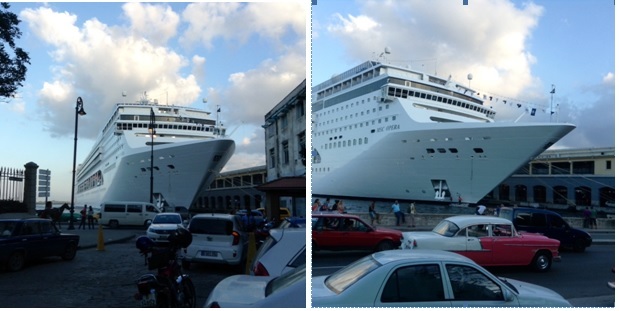
Fig 7. Visual impact in Old Havana. Source: Maruja González
But the same as for natural environment, it is necessary to adopt measures for avoiding the destruction of the intangible assets of the city. The example of Venice or even Barcelona [12] has to be considered as the pressure of tourism is seriously jeopardizing the essential of the cities in such way that their inhabitants prefer not to live in the central areas, leaving a city as an almost empty and dead place.
The impacts of cruises and the massive arrival of visitors could cause a serious damage to the ancient culture of the city. As well as for the beaches and other coast parts, plans for tourism are absolutely necessary.
V. The modelization
There are many possible scenarios, as there are many unknown factors. In any modelization is difficult to foresee the future. But in most of them the past and the starting point are more or less known and it is possible to infer the future taking into account the previous evolution. In this case is very difficult, because the only available information seems to be that a break will take place changing the past and present conditions in a drastically way. Moreover, the answer to questions as where and how are also difficult to get. But what it seems more likely is that an important change will happen, but again without knowing more details.
Taken into account the methodology by Gonzalez and Orro [4] and displacing in the time the previsions that they foresee for 2014, it could be assumed the scenarios of Table 4.
Table 4. Estimations of visitors from USA. Source [4]
|
Visitors from United States of America (Thousands) |
|||||
|
|
2018 |
2019 |
2020 |
2021 |
2022 |
|
Scenario I |
882.2 |
837.8 |
801.4 |
758.5 |
712.9 |
|
Scenario II |
1,203.7 |
1,245.5 |
1,292.9 |
1,341.1 |
1,390.3 |
|
Scenario III |
1,098.8 |
1,109.4 |
1,117.5 |
1,121.2 |
1,121.4 |
|
Scenario IV |
1,464.8 |
1,560.9 |
1,677.6 |
1,757.2 |
1,851.4 |
It has been considered the ability to increase the number of rooms at a rate of 1,000 per year for scenarios I and II and 1700 for the II and III. That will require effort and investment capacity by private entrepreneurs. Also the number of visitors arriving on cruise ships must grow from the current 9,000 [13] .
Those scenarios could be quite conservatives if the cruise capacity is taking into account [14]. As many statistical data in Cuba, is difficult to discern which information is more accurate. The official data shows 9,000 visitors that arrived by cruise, while in some Cuban sites gives 30.000. Nevertheless those figures are irrelevant if they are compared with the millions of visitors that countries as Bahamas receive via cruise each year. Thought many authors focus only on the sun and beach model, the attraction of the Cuban countryside and the cost line (out of the resorts) and especially the cities would make very difficult to stop an increased demand of visitors to those destinations. There are no many cities as Havana in the Caribbean. Is one of the oldest cities in America and its heritage in terms of architectural, dance, music and other amenities makes a very distinct destination in the area.
Nevertheless for a four years period those scenarios seem to be sound, but it is necessary to be prepared for the long term, in which those figure could spiral upwards.
So the perspective is that the possibilities of an increased demand from United States visitors are very feasible. The problem is how to deal with all the requirements that are necessary to receive a fast growing number of visitors. It has to be considered that this model will bring new opportunities for the Cuban population. But at the same time it requires important investments that have to be done by foreign investors. It could entitle the opening to a new economy and in consequence the need of the population to adapt to a new environment.
Cuba needs to be prepared from the environmental point of view. It is necessary to increase the capacity of sewage systems and the construction and renewal of wastewater treatment plants. The support for new eco-tourism developments and the protection of a vast amount of the seashores have to be priorities for the authorities. The enforcement requires the special training of the civil servants in charge of the vigilance of the environmental. The adoptions of corrective and compensatory measures as well as the consideration for the climate change impacts are critical points that have to be assumed.
For modelling the future it has been used a dynamic system approach. This model allows changing the different variables and checking the sensitive and interaction of many different factors. As the evolution of the factors is difficult to predict, the use of different scenarios could help in the analysis of the consequences[15].
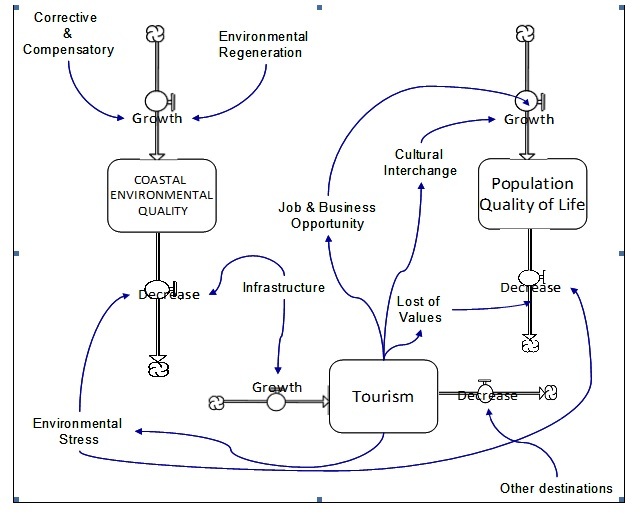
Fig. 8. Dynamic System Model
The model (Fig.7) consider the influence of tourism over the coastal environment as well as in the quality of life of the population. The figure is a schematic diagram of the model.
VI. Conclusion
Cuba is in a transition towards a new model of development and society. The artificial isolation that has suffered along dozens of years is going to be ended, but the pace is still unknown.
The embargo has separated Cuba of the tourist market in the Caribbean especially from the United States that is, with a great difference, the best client in the Caribbean tourism business. Nevertheless Canada and in a minor way European countries are the origin of many visitors to the island, but the potential of the USA as new origin of visitors would be more important and more stable,
Until now most visitors arrive to Cuba by airplane. The cruise transport is almost irrelevant in Cuba while in other Caribbean countries are one of the main modes of visitor’s arrivals. That means that the cruise transport to Cuba will increase rapidly. It will need construction and reformation works, that need investments from the private sector.
At the same time the expected new conditions could affect the ports, the coastal and the cities. It is necessary to eliminate those impacts or at least reduce them taking special measures. It is necessary to set a strategic plan for facing those impacts and for aiding the development of the Cuban people.
Cuba has traditionally offered a sun&beach package, but is being moved towards a cultural and ecological tourism model. The possibilities of the island in this respect are unique.
It is necessary to provide tools to the decision makers so they can asses the consequences of what they are going to choose.
Cuba has one of the most valuables environments, with thousands of kilometer of coastline that has been preserved thanks, somehow to the low development, and that needs to be preserved when Cuba starts a new prosperity age, because this will be the guaranty for the future.
1. KRASIĆ, D.; GATTI, P. Forecasting methodology of maritime passenger demand in a tourist destination. PROMET-Traffic&Transportation, v. 21, n. 3, p. 183-190, 2009. ISSN 0353-5320.
2. MIRANDA PARRONDO, M. D. Los problemas de la inserción internacional de Cuba y su relación con el desarrollo económico. 2009. Universidad Complutense de Madrid, Servicio de Publicaciones
3. SARDIÑAS GÓMEZ, O. F. Maritimidad y turismo en la Habana: una relación para el desarrollo. Investigación & Desarrollo, v. 20, n. 1, 2012. ISSN 2011-7574.
4. GONZÁLEZ NÚÑEZ, G.; ORRO FERNÁNDEZ, R. Cuba y el turismo norteamericano. Analisis de potencialidades y de impactos en la región caribeña. Political Economy of Change in Cuba: Cuba Futures Series, p. 119, 2011.
5. CRUZ, I.; MCLAUGHLIN, R. J. Contrasting marine policies in the United States, Mexico, Cuba and the European Union: Searching for an integrated strategy for the Gulf of Mexico region. Ocean & Coastal Management, v. 51, n. 12, p. 826-838, 2008.
6. Cruise Market Watch. 2016. http://www.cruisemarketwatch.com/
7. MERK, O. The Competitiveness of Global Port-Cities: Synthesis Report. Organisation for Economic Cooperation and Development (OECD). Paris, p.0_1,1-2,7-183. 2013
8. RADER, D. G. Ecotourism in Cuba: A model for sustainable economic development 2015.
9. HOCHSTRASSER CASTILLO, N. El desarrollo ecoturistico para una red mundial de cooperacion entre las bahias mas bellas del mundo, dos casos comparativos: La Bahia de Tadoussac en Quebec, Canada y la Bahia de Banderas en Puerto Vallarta, Mexico. 2009. 135-n/a M.A. (MR49908). Universite du Quebec a Chicoutimi (Canada), Ann Arbor
10. BARRASA GARCÍA, S. El paisaje en América Latina experiencia de valoración participada de paisajes visuales para la planificación ambiental de La Habana - Cuba. 2007. Dissertation/Thesis Universidad Autónoma de Madrid. Departamento de Ecología
11. GÓMEZ DÍAZ, F. De Forestier A Sert. Ciudad y Arquitectura en La Habana de 1925 a 1960. 2007.
12. MAYORGA-CÁRDENAS, M. et al. "Del urbanismo del proyecto urbano al urbanismo ciudadano y de apropiacion social. (1980-2013). Reflexiones sobre las transformaciones urbanas del puerto y frente maritimo de Barcelona". Bitácora Urbano Territorial, Bogota, v. 1, n. 24, 2014. ISSN 01247913.
13. ANUARIO ESTADÍSTICO DE CUBA 2014 CAPÍTULO 15: TURISMO. La Habana: Oficina Nacional de Estadística e Información de Cuba (ONEI) 2015.
14. BECKER, H. Tourism in Cuba: barriers to economic growth and development. Political Economy of Change in Cuba: Cuba Futures Series, p. 139, 2011.
15. KHOO WEN, K.; BT MUSA, N. Responsible tourism system dynamic planning model for rural area. Information and Communication Technology for The Muslim World (ICT4M), 2014 The 5th International Conference on, 2014, 17-18 Nov. 2014. p.1-6.
16. ALVARADO BARRIOS, L. Caracterización del desarrollo de Cuba y su relación con el turismo en el periodo 1995-2005. 2010. Dissertation/Thesis Universidad de Sevilla
17. ANUARIO ESTADÍSTICO DE CUBA 2014 CAPÍTULO 2: MEDIO AMBIENTE. La Habana: Oficina Nacional de Estadística e Información de Cuba (ONEI) 2015.
18. WORLD BANK, T. W. Latin America and the Caribbean Poverty and Labor Brief, June 2013: Shifting Gears to Accelerate Shared Prosperity in Latin America and the Caribbean. World Bank Publications, 2013. ISBN 1464800782.
19. BYE, V.; CHAGUACEDA, A.; TØNNESSEN-KROKAN, B. Which Way Cuba? 2014
20. CAMARERO ORIVE, A.; CAMARERO ORIVE, A. Tráfico marítimo de pasajeros. Fundación Agustín de Betancourt, 2013. ISBN 9788461645381
21. GALLEGOS, C. M.; GRABENDORFF, W. Trends in Maritime Transport and Port Development in the Context of World Trade
22. GRABENDORFF, W. Cuba: reforming the economy and opening society1. 2014. [14] KILDOW, J. T.; MCILGORM, A. The importance of estimating the contribution of the oceans to national economies. Marine Policy, v. 34, n. 3, p. 367-374, 2010. ISSN 0308-597X.
23. KILDOW, J. T.; MCILGORM, A. The importance of estimating the contribution of the oceans to national economies. Marine Policy, v. 34, n. 3, p. 367-374, 2010. ISSN 0308-597X.
24. LUZARDO PADRÓN, M. A. Potencialidades y estrategias para la puesta en valor turístico del frente de agua y casco histórico de los puertos de Altagracia (Venezuela). 2014. Universidad de Málaga, Servicio de Publicaciones y Divulgación Científica
25. MORRIS, E. Unexpected Cuba. New Left Review, n. 88, p. 5-45, 2014. ISSN 0028-6060.
26. MURIAS LÓPEZ, R. La industria del crucero en el siglo XXI. Implicación en los puertos españoles y perspectivas de futuro. 2005. Universitat Politècnica de Catalunya
27. Political Economy of Change in Cuba: Cuba Futures Series. BILDNER CENTER FOR WESTERN
28. STOJANOVIC, T.; FARMER, C. The development of world oceans & coasts and concepts of sustainability. Marine Policy, v. 42, p. 157-165, 2013. ISSN 0308-597X.
29. THORNBURG, J. Eco-tourism and Sustainable Community Development in Cuba: Bringing Community Back into Development: Department of Sociology Benedictine University 2016.
30. ZUBIETA IRÚN, J. L. Teoría de los sistemas portuarios : aproximación al sistema español. 1978. E.T.S.I. Caminos, Canales y Puertos (UPM)







